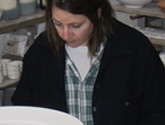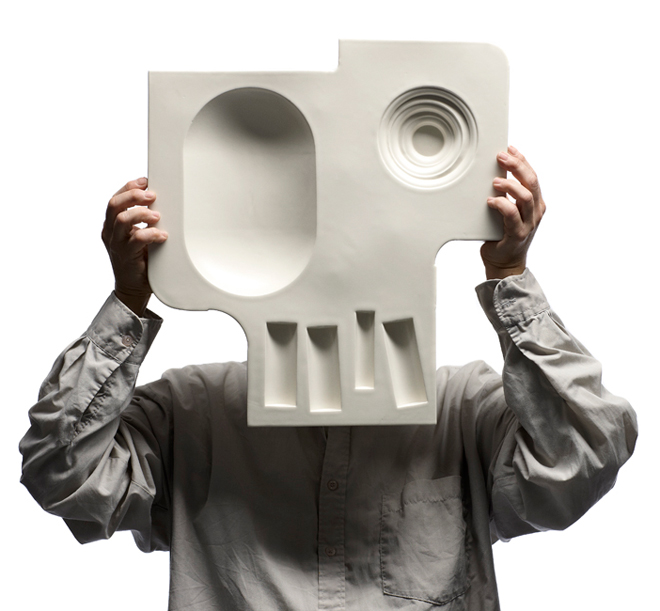


05.01 – 28.01
Anders Ruhwald
![]()
Anne Tophøj and Marianne Nielsen: Elitist Folklore
Welcome to the opening Thursday 25 October 5 – 8 pm
On Saturday 27 October at 2 pm you are invited to an Artist Talk
with Marianne Nielsen and
Anne Tophøj

Anne Tophøj and Marianne Nielsen at Copenhagen Ceramics
Photo: Jeppe Gudmundsen Holmgreen

Anne Tophøj: Fictile 12.3. plate 1 -12
Photo: Jeppe Gudmundsen-Holmgreen

Marianne Nielsen: 'Pine' and 'Cone'
Photo: Jeppe Gudmundsen-Holmgreen

Anne Tophøj: Fictile 12.3. dish 3
Marianne Nielsen: 'Cowberry' and 'Marsh Marigold'
Photo: Jeppe Gudmundsen-Holmgreen

Anne Tophøj: Fictile 12.3. dish 8
Marianne Nielsen: 'Catkins', object for the wall
Photo: Jeppe Gudmundsen-Holmgreen

Marianne Nielsen: Oxeye Daisy, 2012, h 33 x w 20 cm, stoneware with glaze, hand built
Photo: Jeppe Gudmundsen-Holmgreen

Anne Tophøj: Fictil 12.3, dish1, 2012, h 44 x w 41 x d 4,5 cm, porcelain slipcast
Photo: Jeppe Gudmundsen-Holmgreen
![]()
The dish, the plate, the table and the flower. These common everyday objects and the most beloved iconic shapes from nature are framing in the lives of most people. For their shared exhibition at Copenhagen Ceramics Marianne Nielsen and Anne Tophøj are investigating why and how we value these universal expressions of culture and nature. But what is elitist folklore? What does it look like
from their point of view?
Marianne Nielsen occupies a very special position in Danish Ceramics. She takes interest, in an almost nerdy way, in the rôle of nature in our culture. In recent years her work often has concluded in definite renderings of natural subjects: mountains, feathers, leaves and now flowers and plants. As a kind of souvenir they refer to something beyond ourselves, being continuous, universal and something which, through its authenticity, contains an essential beauty. Yet, the representations of nature are about ourselves, since they only acquire their meaning through our very own gaze.
Marianne Nielsen articulates this: ’Flowers hold a modest position in the arts as something banal, soft, often assigned the subordinate part. For these pieces I have let the flower be on its own, allowing it to make up the entire work. The works are about what is not directly present – the references linked to flowers, both as representatives of beauty and natural souvenirs. But they also deal with that particular application that has worn down the flower-motif and turned it into a cliché.’
In a similar way Anne Tophøj is working with the values and inherent meanings of things. Either because the artefacts contain specific images or symbols that pass on a story or message, or by suggesting a particular use or way of handling.
Characteristic of her work she investigates the dish and the plate, objects that we are all very familiar with and make daily use of. As she herself puts it:’ The plate and the dish are signs of human culture
and how we raise ourselves above the animals; they are pivotal in all eating rituals and our daily meals. Artefacts that we all have in common – universal, banal, indispensable tools helping us to sustain life. They are beloved and treasured objects that different cultures and times have shaped endlessly for
use and for ornamentation, for the table and for the wall.’
For this show Anne Tophøj has worked with two types of objects: the dishes, where she uses the surface for primitive and simplified pictorial representations of life and death. She circles about the face and the skull as a common human symbol. In parallel to this she investigates the plate that, as any tool, signals a specific use – the shape being determined by its presumed content. When you look
at her works in the exhibition you have to ask yourself: what are they for? Who will be using them
and how? What will be eaten off them and how do you do that? The answer is in the plate.
Both ceramists have exhibited widely in galleries and museums in Denmark and abroad. Their works have been acquired for public and private collections.
Works by Anne Tophøj are in the collections of The National Museum, Stockholm; Designmuseum Danmark; Trapholt Museum of Art, DK, and she has received the three-year-working grant of the Danish Arts Council. In addition to her personal practice she is teaching part-time at School of Design at the Royal Danish Academy of Art.
Marianne Nielsen has exhibited at The Biennial of Crafts and Design, DK, Design museum Danmark, Ceramics Museum Grimmerhus and many more. She received the Annie and Otto Detlefs Travel Grant in 2011, Ole Haslund Fund, the-three- year working grant of the Danish Arts Council and is represented in its collection. Marianne Nielsen works also as free-lance designer for Kähler Design.
On Saturday 27 October at 2 pm. Copenhagen Ceramics invites to an Artist talk at the gallery with
both artists.
![]()
Copenhagen Ceramics
Smallegade 46, baghuset 2. sal tv
2000 Frederiksberg
Contact: Martin Bodilsen Kaldahl
Mobile: 2728 5452
martin@copenhagenceramics.com
![]()
Wednesday — Friday: 1 – 6 pm
Saturday: 12 am – 4 pm
![]()
Click names to view each artists work:
Marianne Nielsen
Anne Tophøj
02.02 – 25.02
Bodil Manz and Bente Skjøttgaard
01.03 – 24.03
Karen Bennicke and Steen Ipsen
29.03 – 21.04
Turi Heisselberg Pedersen
26.04 – 19.05
Inhabitants — Group show
24.05 – 16.06
Peder Rasmussen and Michael Geertsen
30.08 – 22.09
Louise Hindsgavl and Gitte Jungersen
27.09 – 20.10
Martin Bodilsen Kaldahl
22.11 – 15.12
Christin Johansson